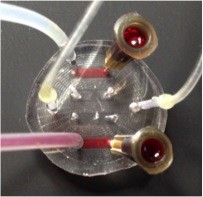Lab on a Chip for Analysis of Leukocyte Trafficking
Workshop held by Scott Simon
28.02.2014
Scott Simon, Professor at the Department of Biomedical Engineering at the University of California in Davis, joined the SFB 914 during his sabbatical in January and February 2014. During his stay he held a workshop entitled “Lab on a Chip for analysis of leukocyte trafficking” to introduce the fabrication, theory, and application of microfluidic devices that integrate one or several measurements of cell function on a single chip.
The workshop was comprised of a theoretical part, where IRTG graduate students, postdocs and several SFB 914 faculty were introduced to the unique physics, microenvironment control, and the process of automation associated with vascular mimetic systems for the study of leukocyte, platelet, and endothelial cell function under defined substrate and fluidic shear conditions.
The introduction was followed by a systems level neuroscience presentation by Professor Leah Krubitzer (University of California, Davis) on the use of a microfluidic based device for reversible thermal deactivation of brain tissue for the study of neuronal circuits.
Mimicking of microscale fluid vessels
Inflammation biologists and bioengineers have employed vascular mimetic microfluidic systems for the past two decades. Biological cells can be viewed as hierarchical ensembles of cooperating units with controlling elements that operate at the micro- and nanoscale. In these systems, dysfunction at the cellular and molecular levels is responsible for a variety of diseases including cancer and cardiovascular disease. A hallmark of blood cells is that they are optimized to function in microscale fluid vessels (e.g. capillaries, venules, arterioles, lymphatic vessels). Considering the similar scales and fluid environments, engineered micro- and nanofluidic devices are ideally suited to diagnose, simulate, and probe biological systems.
Hands on demonstration of chip device
In the laboratory session, the IRTG students received hands on training in the use of microfluidic lab chip devices for observation of neutrophils interacting with E-selectin and ICAM-1 coated  coverslips. Phillipa Timmons from Cellix LTD demonstrated the use of their patented automated microfluidic pump systems for study of leukocyte function on sheared endothelial monolayers.
coverslips. Phillipa Timmons from Cellix LTD demonstrated the use of their patented automated microfluidic pump systems for study of leukocyte function on sheared endothelial monolayers.
The success of this workshop was underscored by Professor Simon’s closing statement: “A prime objective of this workshop was to expose students to the theory and use of microfluidic chips and exchange devices to expand the use of our technology in the labs of SFB 914 faculty”.
Currently, three SFB 914 groups have adopted the lab on a chip technology and are performing experiments.
Image: Vascular mimetic flow channel device (Foster et. al. 2013 PNAS).
Contact:
Prof. Scott Simon
Department of Biomedical Engineering
University of California
Davis, CA 95616
+1 (530) 752-0299
sisimon@ucdavis.edu

